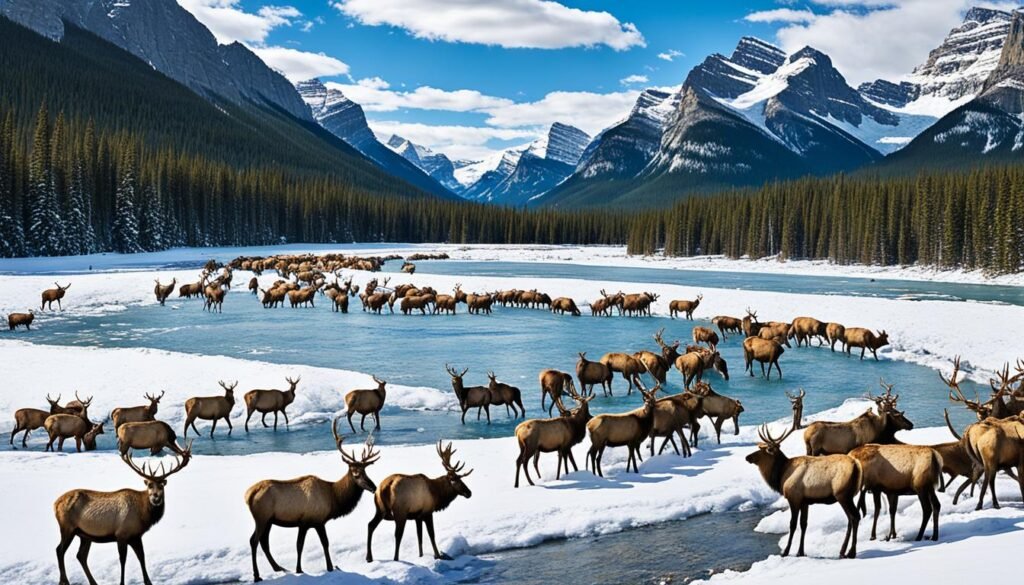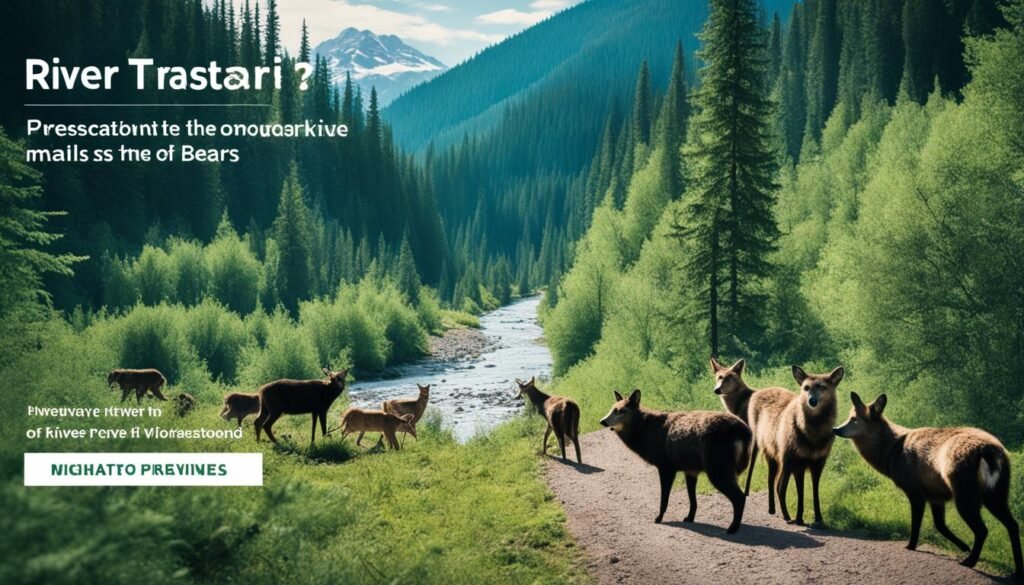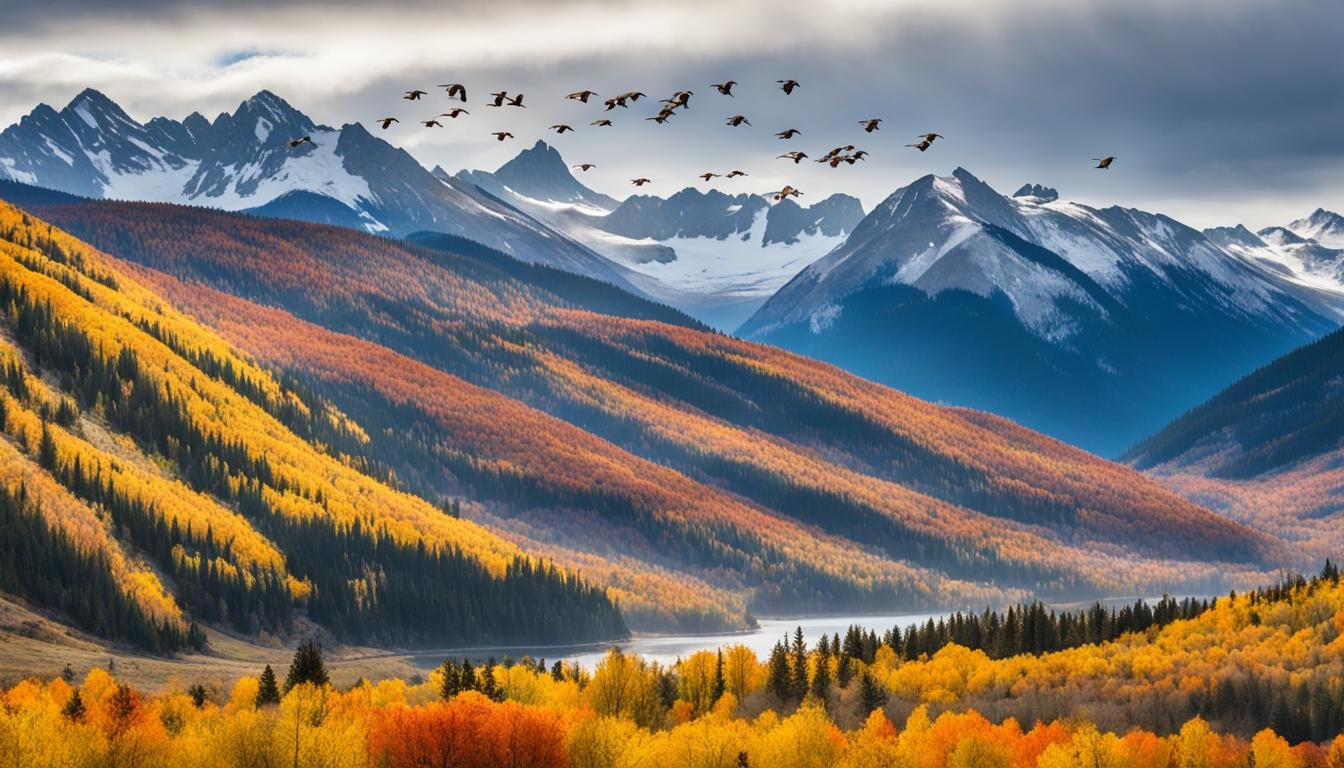Ever wondered why Canadian wildlife makes such long journeys each year?
These animals travel through diverse landscapes, driven by instinct, climate, and environmental changes.
Wildlife Migration Patterns — Quick Summary
Quick picks
Key migration insights
- Triggers: Daylength (photoperiod), temperature, and food pulses initiate most migrations.
- Navigation: Animals use sun, stars, polarized light, geomagnetic cues, and smell maps.
- Stopovers: Wetlands and coastal headlands are vital refueling stations for birds and bats.
- Corridors: Valleys, shorelines, and wind/thermal lanes concentrate movement—watch the “edges.”
- Timing windows: Dawn/dusk and post‑frontal clear nights often produce peak movements.
- Partial migration: Many species have both resident and migrating individuals depending on age/sex/latitude.
- Altitudes & depths: Songbirds migrate at 300–1500 m AGL; whales follow bathymetric contours and prey layers.
- Phenology shifts: Climate change is advancing spring arrivals and altering routes for some species.
- Hazards: Windows, lights, roads, and fencing disrupt routes—dark‑sky and crossing projects help.
- Citizen science: eBird, iNaturalist, and whale sighting networks improve forecasts and conservation.
Local conditions can override general rules—check regional reports before planning.
For example, the Arctic Tern flies an amazing 71,000 kilometers each way, and the Monarch Butterfly goes 6,000 kilometers to Mexico. These journeys are key to keeping nature in balance.
Learning about these migrations helps us protect these animals. It also shows us the big challenges they face due to climate change and losing their homes.
Wildlife Migration
Wildlife migration is a key natural event where animals move seasonally to find food, breed, or escape harsh weather.
These journeys are vital for the survival of species and keeping ecosystems balanced. For example, humpback whales migrate to feeding grounds near polar ice to get the resources they need to survive.
Various animals have different migration patterns. Monarch butterflies fly from Canada to Mexico each year to escape the cold.
Their journey spans generations, guided by strong instincts. Salmon, on the other hand, migrate back to their birth rivers to spawn after living up to seven years in the ocean.
In Tanzania’s Serengeti, a famous migration happens where wildebeests, zebras, and gazelles look for new grass and water during the dry season.
This shows how animals adapt to their changing environments. They respond to things like food availability and predators.
There are different types of migration, including altitudinal, latitudinal, vertical, and circular. Each type has its own challenges like predation, disease, starvation, and exhaustion.
These challenges highlight the importance of migration for nutrient distribution and habitat health.
When migration paths are blocked by humans or natural barriers, animal populations can decline. This can harm both individual species and entire ecosystems.
Scientists are still learning how animals know their migration routes. They think it’s a mix of environmental cues like sunlight and the Earth’s magnetic field.
The details of these wildlife migration patterns show how important animal journeys are for biodiversity and ecosystem health.
Defining Migration: What Sets It Apart?
Migratory behaviour is more than just moving around. It’s a planned journey, known as defining migration.
Unlike other animal movements, migration often happens on a set path every year. These journeys cover long distances and follow straight paths with few changes.
What makes migration special is its unique patterns at the start and end. Animals may get restless, or show zugenruhe, if they can’t migrate as planned.
This shows how their bodies and evolution push them to migrate. There are different types of migration, like diadromy, where animals move between fresh and saltwater.
Studying migration helps us understand wildlife better. We see different types, like obligate and facultative migrations.
Obligate migrants always move to better conditions. Facultative ones might not migrate if it’s not needed. Then there’s partial migration, where some animals stay put while others go.
As animals travel long distances, they use environmental signs to guide them. They move by flying, swimming, or walking. This tells us a lot about how they live and evolve in their environments.
| Type of Migration | Characteristics |
|---|---|
| Obligate Migration | Always migrates, follows predictable routes |
| Facultative Migration | Migrates in response to local conditions |
| Partial Migration | Some individuals migrate while others remain |
| Diadromy | Migrates between fresh and saltwater habitats |
Wildlife Migration Patterns in Canada
Canada is home to a wide variety of wildlife, each with its own migration patterns. These patterns show how animals move seasonally in search of food, places to breed, and suitable climates.
As the climate and habitats change, Canadian migratory species must adapt to survive.
This section looks at the complex migration routes of these animals. It also highlights their amazing ability to travel long distances. They do this to find the resources they need to live.
Overview of Seasonal Movements
Many species rely on seasonal movements to survive and reproduce. In Canada, these movements are influenced by the environment. As temperatures rise and habitats change, more species will need to adapt their ranges.
Research suggests that cities like Quebec City, Ottawa, and Winnipeg may see more wildlife. This is because warmer and wetter conditions will attract turtles, mice, toads, and pelicans to urban areas.
However, not all species will benefit from these changes. Some, like loons and wild dogs, may lose their habitats. This could lead to fewer sightings in cities.
The arrival of new species can also bring risks, such as pests that could harm local ecosystems and food supplies.
Examples of Canadian Migratory Species
Some Canadian species are known for their incredible journeys and unique behaviors. The Arctic Tern is one such example. It travels thousands of kilometers between the Arctic and the Southern Hemisphere each year.
Another example is the Whooping Crane, which makes a long journey from Canada to the Gulf Coast of Texas. This shows its strength and reliance on specific migration routes.
About 327 bird species live in the Boreal Forest region, making up nearly half of North America’s bird life. These migrations can be affected by many factors, including weather and human-made structures.
Birds often die from hitting buildings, wind turbines, and communication towers, causing more deaths than other hazards combined in Canada.
| Species | Migration Route | Distance Traveled (Round Trip) |
|---|---|---|
| Arctic Tern | Arctic to Southern Hemisphere | Approximately 70,900 km |
| Whooping Crane | Canada to Texas Gulf Coast | Approximately 4,800 km |
| Boreal Forest Birds | Various migration routes in North America | Varies by species |
Animal Migration Routes Across Canada

Canada’s diverse landscapes support many animal migration routes. These routes are key for keeping nature in balance. They show the challenges faced by different species. Knowing about these routes helps us value wildlife and see why we must protect it.
Land-Based Migration
In Canada, land migration is seen with many iconic animals. Caribou migrate across the tundra, covering over 5,000 kilometers a year.
Elk also migrate, moving through forests and grasslands. These journeys are long, with caribou facing challenges like fences and highways.
Marine Animal Migratory Routes
Marine routes are just as fascinating, showing how ocean life connects. Humpback Whales travel from the North Atlantic to warmer waters for breeding. Climate change affects their food and migration paths.
| Species | Migration Distance | Habitat Type | Challenges Faced |
|---|---|---|---|
| Caribou | Up to 5,000 km | Tundra | Habitat loss, physical barriers |
| Humpback Whale | Over 25,000 km | Ocean | Climate change, food availability |
| Elk | Variable, ~500 km | Forests, grasslands | Fragmented habitats, roads |
We must keep an eye on these migration routes to protect them. Working together, we can help animals migrate safely. This includes efforts from private landowners and industries to keep habitats connected.
Bird Migration Behaviour: Highlights from Canadian Species
Bird migration shows the amazing journeys of different species across vast distances. The Arctic Tern and Monarch Butterflies are notable for their unique migration patterns.
These patterns show how they adapt to environmental changes and survive. Every year, millions of birds move to and from their Canadian homes. But, many species face big challenges that threaten their survival.
The Majesty of the Arctic Tern
The Arctic Tern is known for its incredible migration, flying up to 71,000 kilometres a year. This long trip takes them from the high Arctic to the southern hemisphere. They use the stars, land features, and the Earth’s magnetic field to navigate.
This bird’s journey is vital for the marine ecosystems it lives in. It helps keep the balance in these environments.
Monarch Butterflies and Their Unique Journey
Monarch Butterflies also make a remarkable migration. They travel from North America to central Mexico, covering thousands of kilometres. This journey is done over several generations, showing a unique multi-generational migration.
Monarchs use environmental signs and temperature changes to time their migration. But, they face big challenges from habitat loss and climate change.
Saving their migration paths is key to making sure future generations can continue this amazing journey.
Migration Tracking Data: Understanding Movement
Migration tracking data is key to understanding wildlife movements. It shows us how animals move and helps us learn about their journeys. New methods like the Motus wildlife tracking network help track species.
The Motus network started in 2014 in the US and Canada. It uses over 40,000 transmitters and 1,500 receiver stations across 34 countries. It mainly tracks birds, helping researchers see where they go.
Some Ontario Parks use Motus to help endangered species like the Loggerhead Shrike and the Common Nighthawk. Satellite tracking helps with caribou, sea turtles, and whales too. It gives us info on their movements and what they eat.
New tech like the Internet of Things (IoT) is changing wildlife tracking. It uses machine learning and sensor networks for real-time data. PIT tags track animals without touching them, keeping their natural habits intact.
Geolocators, or “geologgers,” have improved our knowledge of small bird migration. They use light sensors to figure out where animals are. The ARGOS satellite network also tracks many migratory species accurately.
| Tracking Method | Species Tracked | Key Benefits |
|---|---|---|
| Motus Network | Primarily birds | Large-scale tracking, collaboration with international partners |
| Satellite Tracking | Caribou, sea turtles, whales | Real-time location data, extensive movement analysis |
| Stable Isotope Analysis | Various species | Diet and location analysis without recapture |
| PIT Tags | Wide range of species | Non-invasive tracking, longevity in data collection |
| Geolocators | Small migratory birds | Light-based location tracking, minimal animal handling |
Advances in tracking data are a big step forward for understanding and protecting animal migration. These methods give us vital info. They help us protect endangered species and shape conservation efforts.
Factors Influencing Migration Patterns
The movement of wildlife shows a complex mix of factors at play. Seasonal changes and climate impacts are key in setting the timing and paths of migration. These factors are crucial for the survival and balance of ecosystems.
Seasonal Changes and Climate Influence
Seasonal changes greatly affect animal behavior and when they migrate. The change in temperatures and food availability sets the stage for their journeys.
For instance, the Arctic tern travels over 50,000 miles yearly, adapting to climate changes to find food and survive.
Studies show a concerning trend as species move to higher grounds at a rate of 36 feet per decade. Environmental changes pose big challenges for many species during their migration.
Billions of birds face dangers that greatly impact their numbers, made worse by structures and bad weather. Caribou migrations are now delayed because of warmer temperatures, showing how climate change affects migration times.
The Impact of Global Migration Patterns
Migration is not just a local event. Global patterns show how changes in one place can affect others.
For example, warmer oceans have led to puffins breeding later and having fewer chicks. Sea turtles now face threats from eroding beaches and imbalanced sex ratios because of rising sea levels.
As species like the beluga whale adjust to changing ice, it’s clear climate change brings many challenges.
These changes alter migration paths and habitats. Understanding these factors is key to protecting endangered species and their habitats.
Wildlife Migration Conservation Efforts

Conservation efforts are key to keeping ecosystems healthy and stable. They help protect species that move between different areas.
Many groups in North America have gotten a lot of funding to work on this. They’re using it to save wildlife migration by keeping habitats safe and trying new ideas.
Protecting Migratory Species
Many grants have gone to projects to save migratory species. For example, the Colorado Department of Transportation got $480,400 to help deer and elk cross safely. This will cut down on accidents between animals and cars.
The Mule Deer Foundation in Idaho got almost $310,000 to make better fencing and homes for deer and other animals over 255,000 acres. These projects show how important it is to make safe paths for wildlife during their big moves.
Importance of Habitat Preservation
Keeping habitats safe is key to saving wildlife migration. Many projects are about fixing and protecting important places.
The Mississippi River Trust and The Nature Conservancy got $654,000 and $696,000, respectively, to fix wetlands for birds in the Mississippi Alluvial Valley.
The American Littoral Society got $987,000 to make beaches safe for shorebirds. These programs show how important it is to keep environments healthy for migrating animals.
It’s crucial to understand how to protect wildlife migration. Climate change and losing habitats are big threats. We need ongoing efforts and awareness from everyone. With action and smart policies, we can save both the animals and their homes.
The Role of Technology in Migratory Species Monitoring
Technology has changed how we study wildlife, especially migratory species. Tools like GPS and acoustic devices give us deep insights into animal movements and patterns.
These tech advances help us collect more accurate data, which is key to understanding how climate change affects migration.
Tracking Systems and Methods Used
Today, many tracking systems help us study migratory species better. Since the 1980s, satellite telemetry has been a major tool. It has different accuracy levels, with the most precise being less than 150 meters off.
GPS systems are even more accurate, with errors around 5 meters. This makes them a reliable choice over older systems.
Small satellite transmitters, starting in 2006, weighed just 9.5 grams. But, they can’t be used on animals under 240 grams.
Devices over 5% of an animal’s weight can drain their energy during migration. These devices can cost over $3,000, which can limit the number of animals studied.
Using GPS and biotelemetry lets us measure animal behaviour and health without always knowing their location.
The Canadian Wildlife Federation uses this to study endangered species like the Leatherback Sea Turtle. Radio telemetry is also useful for tracking bats, and acoustic devices help us understand sound interactions in their habitats.
Impact Analysis of Climate Change on Migration
Technology and climate change work together in complex ways. PIT tags, like microchips, help the Canadian Wildlife Federation track the American Eel’s migration. This shows how environmental changes affect their journey.
Radar technology also sheds light on bird migration. It tells us about flight times, directions, and wing patterns.
Citizen science apps like iNaturalist Canada let people record wildlife sightings. This helps us understand migration and highlights the importance of community involvement.
By combining these technologies, we get a better view of how climate change impacts migration and species adaptation.
Conclusion
Understanding wildlife migration is key to keeping ecosystems healthy in Canada. Species like the Arctic tern travel over 44,000 miles, showing us why we need to pay attention. These long journeys are crucial for keeping nature in balance.
Climate change is making animals change their migration paths and times. This can hurt their breeding and food supply.
So, we must keep studying these changes to help protect these animals and their homes. Using technology like satellites helps us learn more about their movements.
Protecting Canadian wildlife depends on working together. Governments, scientists, and communities must join forces.
By following global agreements, we can protect the paths these animals take. For more on how fish adapt, check out understanding fish locomotion.
FAQ — wildlife migration patterns
Big moves. Clear reasons. Smart timing.
They’re seasonal movements between habitats to find food, breed, or survive harsh conditions, followed by a return trip. Migration is different from dispersal because the journey is cyclical, not one-way. Many species use the same routes year after year, forming predictable corridors.
Main drivers: food, breeding sites, safer climate, and fewer predators or parasites. Moving lets animals match peak resources—like insects or new plant growth—and boost survival of young. The payoff must exceed big costs: energy use, exposure, and risks from storms or hunting.
They read cues like day length, temperature, wind, currents, and landmarks. Internal clocks and compasses help—sun and star maps, Earth’s magnetic field, and even scent trails. Species and populations learn routes culturally too, following elders along traditional corridors.
Common types include latitudinal (north–south), altitudinal (up/down mountains), longitudinal (east–west), and aquatic movements between rivers and oceans. Migrations can be obligate (every year) or facultative (only when conditions demand it). Some are partial—only part of a population moves.
Aerial surveys in 2024 identified about 6 million antelope in South Sudan—white-eared kob, tiang, Mongalla gazelle, and bohor reedbuck—moving across the Boma-Badingilo-Jonglei landscape. This mass movement appears to surpass other famous land migrations. It underscores how protecting vast corridors is critical.
Source Links
- https://www.aiwc.ca/blog/what-is-migration/
- https://blog.cwf-fcf.org/index.php/en/astounding-migrations/
- https://parks.canada.ca/nature/science/especes-species/voyageurs-travellers
- https://education.nationalgeographic.org/resource/migration/
- https://www.pewtrusts.org/en/research-and-analysis/reports/2022/10/how-to-conserve-wildlife-migrations-in-the-american-west
- https://fastercapital.com/topics/introduction-to-wildlife-migration.html
- https://dir.princeton.edu/include/pdf/2001_Rubenstein_Ency_Migrat.pdf
- https://academic.oup.com/bioscience/article/57/2/113/228325
- https://www.cbc.ca/news/science/urban-wildlife-climate-1.7156253
- https://birdcanada.com/birds-of-canada/bird-migration/
- https://www.natureconservancy.ca/assets/documents/nat/NCC_migration_ENG.pdf
- https://www.npr.org/2022/07/19/1111740540/canadian-researchers-seek-paths-for-animals-to-migrate-in-response-to-climate-ch
- https://www.nps.gov/articles/000/migrationmapping.htm
- https://pibo.ca/en/wp-content/uploads/2021/03/CW-MarApr-Migratory-Birds.pdf
- https://www.allaboutbirds.org/news/the-basics-how-why-and-where-of-bird-migration/
- https://en.wikipedia.org/wiki/Animal_migration_tracking
- https://www.ontarioparks.ca/parksblog/motus-migration-tracking/
- https://movementecologyjournal.biomedcentral.com/articles/10.1186/s40462-021-00268-4
- https://www.fws.gov/story/migration-its-risky-journey
- https://www.neefusa.org/story/climate-change/how-climate-change-changing-animal-habits
- https://cpree.princeton.edu/conservation-migratory-wildlife
- https://www.ncbi.nlm.nih.gov/pmc/articles/PMC5637735/
- https://www.nature.com/scitable/knowledge/library/satellite-telemetry-and-its-impact-on-the-94842487/
- https://blog.cwf-fcf.org/index.php/en/how-technology-helps-wildlife/
- https://academic.oup.com/book/25920/chapter/193665225
- https://www.ujecology.com/articles/tracking-wildlife-migration-patterns-in-a-changing-climate.pdf

